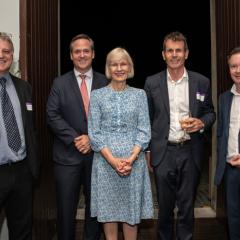There are tens of thousands of CSG wells to be drilled in Queensland and hundreds of thousands of water and old coal bores in existence. Most of these will need to be plugged and decommissioned at some time in the future.
New technologies are being developed at UQ to do this, but how do we know they will be effective at preventing future escape of gas (or water)?
Today, a new UQ Well Simulator Facility was launched when the Dean of the Faculty of Engineering, Architecture and Information Technology (EAIT), Professor Simon Biggs, cut the red ribbon to officially declare its inaugural start.
Many months of innovative research, calculations, testing and construction have been leading up to the launch, led by Professor Brian Towler's team from the School of Chemical Engineering with Dr Heinz-Gerd Holl as chief investigator.
The Well Simulator has been developed with funding from the UQ Centre for Coal Seam Gas, which is funded by UQ and industry members Arrow Energy, APLNG, Santos and Shell/QGC. This new research is also part-funded through a grant from the Advance Queensland Innovation Partnerships (AQIP) program.
The 5 tonne, 6 meter high facility will initially be used to test the stability of UQ’s new bentonite plugs under borehole conditions. In the longer run, the facility will provide an isolation testing facility for a number of technologies for the onshore gas industry in Queensland and beyond.
Director of the Centre for Coal Seam Gas Professor Andrew Garnett said that today’s launch is a great achievement in terms of providing a controlled, scientific test facility in Queensland for development of improved plugging technologies in realistic conditions.
“We built this simulator facility to find and develop new well and innovative bore decommissioning technology that has potentially better environmental performance than existing technology”, Professor Garnett said.



